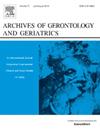Mesencephalic astrocyte-derived neurotrophic factor inhibits neuroinflammation through autophagy-mediated α-synuclein degradation
IF 3.5
3区 医学
Q2 GERIATRICS & GERONTOLOGY
引用次数: 0
Abstract
Parkinson's disease (PD) is the second most prevalent neurodegenerative disorder marked by the progressive loss of dopamine neurons in the substantia nigra. α-synuclein (SNCA) aggregation-induced microglia activation and neuroinflammation play vital role in the pathology of PD. Our previous studies showed that mesencephalic astrocyte-derived neurotrophic factor (MANF) could inhibit SNCA accumulation and Lipopolysaccharides (LPS)-induced neuroinflammation, but the specific molecular mechanism remains unclear. In this study, we showed that knock-down the expression of MANF leads to the up-regulation of inflammatory factor tumor necrosis factor-α (TNF-α). Exogenous MANF protein inhibits LPS-induced neuroinflammation in BV2 cells. Additionally, our results indicated that knock-down of the expression of MANF triggered autophagic pathway dysfunction, while exogenous addition of MANF protein or using adeno-associated virus 8 (AAV8) mediated MANF over-expression could activate the autophagic system and subsequently suppress SNCA accumulation. Furthermore, using autophagy inhibitor to block autophagic flux, we found that MANF prevented neuroinflammation by autophagy-mediated SNCA degradation. Collectively, this study indicated that MANF has potential therapeutic value for PD. Autophagy and its role in MANF-mediated anti-inflammatory properties may provide new sights that target SNCA pathology in PD.
中脑星形胶质细胞源性神经营养因子通过自噬介导的α-突触核蛋白降解抑制神经炎症
帕金森病(PD)是第二常见的神经退行性疾病,其特征是黑质中多巴胺神经元的进行性丧失。α-突触核蛋白(SNCA)聚集诱导的小胶质细胞活化和神经炎症在PD的病理过程中起重要作用。我们前期的研究表明,中脑星形细胞源性神经营养因子(MANF)可以抑制SNCA的积累和脂多糖(LPS)诱导的神经炎症,但具体的分子机制尚不清楚。在本研究中,我们发现敲低MANF的表达可导致炎症因子肿瘤坏死因子-α (TNF-α)的上调。外源性MANF蛋白抑制lps诱导的BV2细胞神经炎症。此外,我们的研究结果表明,敲低MANF的表达会引发自噬通路功能障碍,而外源添加MANF蛋白或使用腺相关病毒8 (AAV8)介导的MANF过表达可以激活自噬系统,从而抑制SNCA的积累。此外,使用自噬抑制剂阻断自噬通量,我们发现MANF通过自噬介导的SNCA降解来预防神经炎症。总之,本研究表明,MANF对帕金森病具有潜在的治疗价值。自噬及其在manf介导的抗炎特性中的作用可能为PD中SNCA病理提供新的视角。
本文章由计算机程序翻译,如有差异,请以英文原文为准。
求助全文
约1分钟内获得全文
求助全文
来源期刊
CiteScore
7.30
自引率
5.00%
发文量
198
审稿时长
16 days
期刊介绍:
Archives of Gerontology and Geriatrics provides a medium for the publication of papers from the fields of experimental gerontology and clinical and social geriatrics. The principal aim of the journal is to facilitate the exchange of information between specialists in these three fields of gerontological research. Experimental papers dealing with the basic mechanisms of aging at molecular, cellular, tissue or organ levels will be published.
Clinical papers will be accepted if they provide sufficiently new information or are of fundamental importance for the knowledge of human aging. Purely descriptive clinical papers will be accepted only if the results permit further interpretation. Papers dealing with anti-aging pharmacological preparations in humans are welcome. Papers on the social aspects of geriatrics will be accepted if they are of general interest regarding the epidemiology of aging and the efficiency and working methods of the social organizations for the health care of the elderly.

 求助内容:
求助内容: 应助结果提醒方式:
应助结果提醒方式:


